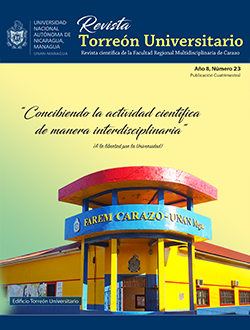Removal of hexavalent chromium in contaminated water using banana peel (Paradisiac musea) as adsorbent
DOI:
https://doi.org/10.5377/torreon.v8i23.9534Keywords:
hexavalent chromium, biomass, isothermal models, removal, adsorptionAbstract
This research aimed to remove the hexavalent chromium from contaminated water using the banana peel as an adsorbent. The study was realized in two stages: in the first stage, it worked with 1 g of the biomass at a particle size of approximately 600 µm, 5 minutes of contacts, 20 mg.l-1 of hexavalent chromium and at pH 3, 3,5, 5 and 7. In the second stage, it worked with the mass and time conditions at pH 3 and 3.5, increasing the metal concentration from 20 to 40 and 80 mg.l-1. The results obtained show that increasing the pH reduces the removal percentage and the adsorption capacity, however, at pH 3 and 3,5 the biomass removes almost 100% of the hexavalent chromium and increasing the concentration increases the adsorption capacity of the banana peel. The experimental data fit more to the Langmuir model than to the Freundlich model, which shows monolayer adsorption of a homogeneous surface. Also, the separation factor RL was between 0,809 and 0,383 which indicated favorable adsorption of the heavy metal in the biomass. The banana peel has great potential as an adsorbent for the removal of hexavalent chromium in water.
Downloads
Downloads
Published
How to Cite
Issue
Section
License
The authors who publish in this journal agree to the following terms.
- The author or authors of the articles, essays or research grant the National Autonomous University of Nicaragua, Managua (UNAN-Managua) the editing rights (copyright) of the submitted work, therefore the University has the exclusive right to publish the article for the entire copyright period.
- These copyrights/authors authorize Torreón Universitario Magazine and the University to edit and disseminate/publish the article in said Magazine, including printed and electronic reproduction, storage, retrieval and any other type of publication, and sources of secondary information as services. of summaries and databases, they also empower it to protect the article against unauthorized use for dissemination by printed or electronic media (PDF, HTML, EPUB, XML or others).
License for use of content
The magazine uses the Creative Commons Attribution-NonCommercial-NoDerivs 4.0 International License.
Under this statement:

This journal is licensed under a Creative Commons Attribution-NonCommercial-NoDerivatives 4.0 International License. It can be copied, distributed and transmitted publicly as long as the author and source are cited (Revista Torreón Universitario), it should not be modified or used for any commercial purpose. The full license can be found at http://creativecommons.org/licenses/by-nc-nd/4.0/.



